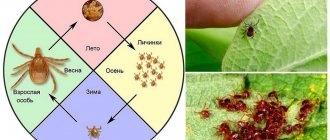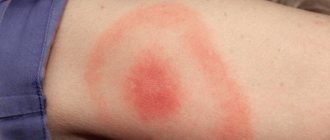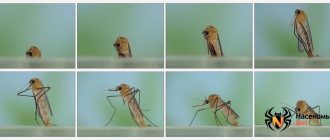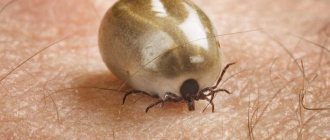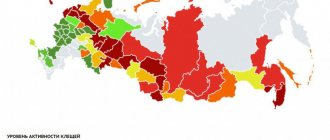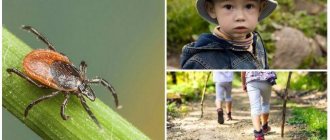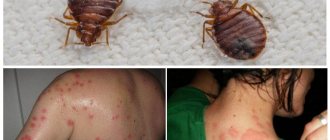As soon as winter ends and warming begins, authorities begin to implement policies to alert the population to the danger. What is the reason for such activity of the authorities? This is explained by the fact that it is at this time that ticks appear in the forests, which pose a mortal threat to human health.
As carriers of serious diseases, they can cause significant damage to human health. After all, signs of infection do not appear immediately, but after some time. And therefore, any delay can turn into a tragedy. To protect yourself, a person needs to clearly understand when there is danger.
When tick season begins and when it ends, this is information that all citizens should have in order to be able to protect themselves. It is quite problematic to accurately determine the beginning of the season. This is due to different weather conditions. Scientists remind that as soon as a stable warm temperature is established, the parasites wake up. In other words, as soon as the snow melts and the temperature rises to 15–20 degrees, the chances of encountering this parasite in the forest will increase.
When do ticks appear?
Already in April - May, patients with tick bites come to the hospital. Because it is during this period that they appear on the soil surface. Somewhere from mid-April, when the weather is warm and the sun warms the ground well, thawed patches appear. And at this time the ticks wake up.
Due to the fact that these insects are constantly in search of food, the number of victims increases sharply. Please note that in the future their activity does not depend on the weather. Even if the summer is quite cool, dangerous insects will continue their “hunt”. Therefore, care must be taken even in rainy weather.
Symptoms of a tick bite
The primary negative symptoms of a tick bite are:
- Redness and thickening of the skin at the site of the bite and around it;
- Slight itching.
Further, depending on the individual allergic reaction, weakness, dizziness, lack of appetite, etc. may develop.
If the tick was a carrier of encephalitis, an increase in temperature, fever, headaches, nausea, vomiting, diarrhea, etc. is observed within two weeks. In the case of a bite from a carrier of borreliosis, along with the above signs, a spot with a border appears at the site of the bite, a runny nose, and a sore throat.
When does tick season end?
We are talking about the summer period, so when going on vacation, a person wants to be sure that he will be completely safe. This issue becomes especially relevant in August. When the heat subsides, it begins to seem that it is more difficult to meet a tick in the forest or in the park.
This is due to the number of ticks, because it is rapidly decreasing. And therefore, in the middle of summer, people who have been bitten practically do not turn to doctors for help. Such a decrease in numbers is associated with the death of insects. The cause of death is the lack of reserve nutrients in their body.
But this does not mean at all that in August or September you can not worry and relax calmly. Experts assure that parasites can be found in parks and forests even in October. Provided the weather is favorable. That is why it is generally accepted that the tick season ends with the first noticeable cold weather.
Myth. It is easy to remove a tick by pouring oil or gasoline on it.
In fact . It is better to remove the tick at the emergency room. But you can do it yourself. You should use tweezers or thread (but don’t use your bare hands, there is a risk of damaging the tick, and it will partially remain in the skin, causing suppuration). It is absolutely forbidden to pour oil, cologne or anything else on the tick - otherwise it will die and remain in the wound. The tick must be grabbed as close to the head (that is, to the skin) as possible and carefully, slowly twisted or pulled out of the wound. After removing the bloodsucker, it must be placed in a matchbox and taken for examination. And treat the wound with an antiseptic (and do this for several days until it heals).
Peak parasite activity
According to scientists, ticks are most active from the beginning of April to the end of June. During this period they are looking for food, so the frequency of attacks on animals and people increases. It is especially dangerous during such a period to be not only in the forest, but also in pastures. After all, first of all, warm-blooded animals such as cows, sheep, and goats suffer from them.
The period when ticks are most active largely depends on the following factors:
- Satiety of parasites - at the moment when ticks are satiated, they begin to be more concerned about reproduction than nutrition;
- The number of small mammals, arachnids - ticks are food not only for birds. Spiders and amphibians also feed on them. And if the number of natural enemies of parasites is large enough, then their population is significantly reduced. However, if there is regular treatment using toxic chemicals that kills spiders and other amphibians, mite numbers increase;
- Human activity - parasites try to stay closer to the food supply. Therefore, it is quite expected that their numbers will be quite impressive in places where livestock are commonly grazed.
As you can see, a variety of factors can provoke a peak in activity. And therefore it is quite difficult to predict it accurately.
Life cycle
Individuals in the nymph stage, as well as fertilized females, go to winter. Speaking of nymphs, these individuals continue to develop in winter. But the females wait for spring to lay eggs and continue the population. Regarding the laying of eggs, there are a huge number of them, not hundreds, but thousands of the new young generation. The life cycle of a bloodsucker depends on many factors, but on average it is 2 years. During this period, one individual can change 3 owners.
These parasites are dangerous already at the stage of larvae that emerge from eggs. For further development they need food. Most often, their victims are rodents, small animals and birds. They attack the victim, feed on blood and fall off. Then, in the warmed ground, they molt and move into the next nymph stage. If an individual enters the nymph stage in the summer, it looks for a new victim; when it is autumn, then at this stage the individual hides for the winter.
At the nymph stage, the individual also needs nutrition for further development. Both wild and domestic animals, rodents, birds can become victims of the nymph, and they can also attack people. When she is satisfied with blood, she herself falls away from the victim’s body. Once on the soil, it enters the adult stage. These are young individuals that, after being saturated with blood, become sexually mature and ready to reproduce. They continue their activity in the spring, when they lay eggs.
Period of activity in the Leningrad region
As we have already found out, the period of appearance of parasites is difficult to determine precisely. But another interesting fact is that not in all areas the situation with bites is critical. There is a special map on which endemic zones for tick-borne encephalitis are clearly marked. The Leningrad region is also an endemic zone.
Tick habitat map
Therefore, predicting when ticks appear in the Leningrad region is a little easier. This is due to a certain static nature. In such areas they appear regularly and at approximately the same time. Due to specific weather conditions, the period of their activity is not so long. Ticks appear in early April and remain dangerous until mid-May.
It is noteworthy that scientists predict a worsening of the situation in this region. According to statistics, every year the number of people who contact the clinic with a complaint of a parasite bite increases (despite the fact that the Leningrad region is in the yellow zone on the map, tick activity increases every year). Although in other endemic zones its decline is observed. In the Leningrad region, according to experts, the situation is almost critical and requires greater caution from people.
Period of activity in the Moscow region
The period of ticks in Moscow begins at the end of April, beginning of May. The first to suffer from them are small rodents, wild hares, and dogs. It is during this period that breeders complain that they find ticks on the fur of their four-legged pets. If we talk about people, the first victims are summer residents and those who like to celebrate the May holidays in nature.
But since ticks love dry, moderately warm weather, at the height of summer their activity declines. In June and July they practically do not bother people. However, if the weather is favorable for them, the situation may change. But if the summer is really hot, then insects resume activity only at the end of August.
Precautions when visiting dangerous areas and places
You can pick up a tick anywhere, even in Moscow, St. Petersburg, Kyiv, Minsk or any other city. But most often they occur:
- in a forested area;
- in a forested area;
- on a summer cottage.
For forest walks and outdoor recreation, choose closed clothing; the collar of your outerwear should fit close to your neck, and it is advisable to tuck in your T-shirt. Sleeves and trouser legs should be long. It is better to wear rubber shoes, preferably high boots. Cover your head with a headscarf or cap. If the clothes are light, then it will not be difficult for you to see a tick crawling on it.
For stops and parking in the forest, choose dry pine meadows without tall thickets. Don’t sit on the ground, much less lie down on the grass. Before and after spending the night, be sure to inspect your entire body.
From time to time, inspect yourself and your loved ones for the presence of bloodsuckers. This issue should not be taken lightly. If you find a tick that has not yet attached itself, remove it from yourself. If it has stuck, then the faster you remove it, the less the risk of contracting a serious disease.
Forest clothing must be stored separately from regular clothing so that ticks do not transfer to it. Upon arrival from the forest, inspect your clothes, shake them out in a place away from populated areas and put them in a bag and tie it tightly. Another good way to protect your clothes from ticks is to treat them with an acaricide before and after a walk in the forest.
Use products that repel or kill ticks. The drugs can be purchased at pharmacies and hardware stores. Before purchasing and using, be sure to read the instructions.
Remember! There are three main types of tick sprays:
Repellent
– repels ticks, can be applied to exposed skin. They last for about 2-5 hours, then disappear.
Acaricidal
– kill ticks, applied to clothing, not applied to skin. The effect lasts up to several days.
Acaricidal-repellent
– at the same time they repel and, in case of contact of the parasite with the substance, paralyze it.
In what weather are insects most dangerous?
Quite often, experts hear from people the question of how the weather affects the activity of parasites. Indeed, temperature conditions can largely affect the activity of ticks. The most favorable range is considered to be from 15 to 20 degrees Celsius. They do not tolerate heat very well, so on a dry, sunny day the chances of becoming a victim of this parasite are negligible.
They are also affected by air humidity. And, unfortunately, many people forget about this. Moreover, there is an opinion that rain helps to reduce their activity. Of course, walking through the forest during rain, you are completely safe. But in general, moisture is a favorable factor for them. It is noteworthy that insects prefer cloudy weather. After all, the air is saturated with humidity. This is why walking through a forest, park or pasture in cloudy weather is not a good idea. Even if it's summer, like August. It is important to remember that ticks can attack even in September or October.
From what has been written above, we can conclude that determining the exact time when ticks awaken is not an easy task. This is true. Moreover, in certain areas they are activated much earlier. For example, residents of the Leningrad region are forced to put up with the fact that these parasites begin to attack them in early spring - early April. But in other areas they may appear in May or even early June.
That is why quite often people ask specialists another question: what temperature is favorable for ticks to awaken? After all, knowing this, it is much easier to predict exactly when to start fearing for your health and take precautions.
When answering the question at what temperature ticks are activated, it is necessary to mention that awakening occurs at a fairly low temperature - only 1-3 degrees Celsius. Why does no one come to the clinic with complaints during this period? This is explained by the fact that at this temperature people dress quite warmly. And therefore the risk of being attacked by a parasite is practically zero. Consequently, the awakening of ticks itself remains largely unnoticed by people.
How parasites behave at night
As you know, some species of animals, reptiles, and arachnids are more active at certain times of the day. For example, some species of spiders prefer to go hunting in the dark. But does this rule apply to ticks? Perhaps at night or early in the morning a person can feel relatively safe?
Studies that have been carried out repeatedly have shown that ticks have no connection to the time of day. They can be dangerous both at night and during the day. However, it is necessary to make a small clarification. On hot summer days, when the temperature reaches 30 degrees, the activity of parasites decreases. They prefer to stay in their hiding places and not attack victims.
But as soon as night falls, bringing with it coolness, they leave their shelters. And that is why the illusion is created that periods of their activity may depend on the time of day. But in reality this is not the case. The only thing that can affect the activity of ticks is weather conditions. If they are favorable, the ticks will begin searching for food.
Myth. Ticks jump from trees. You can become infected even while walking along the alleys of the park.
In fact . Ticks live near the ground and attack only from grass and small bushes. Therefore, if a person walks along a path without turning into the grass, he is not afraid of ticks. But sometimes owners can get ticks from their pets, from whose fur the ticks quickly run towards them. Climbing up the human body, ticks look for places convenient for suction. They often settle in the groin, under the arms, and on the neck. Therefore, upon returning from “risky” walks, it is important to completely undress and carefully examine yourself and your children, pets, and the clothes you have removed too.
